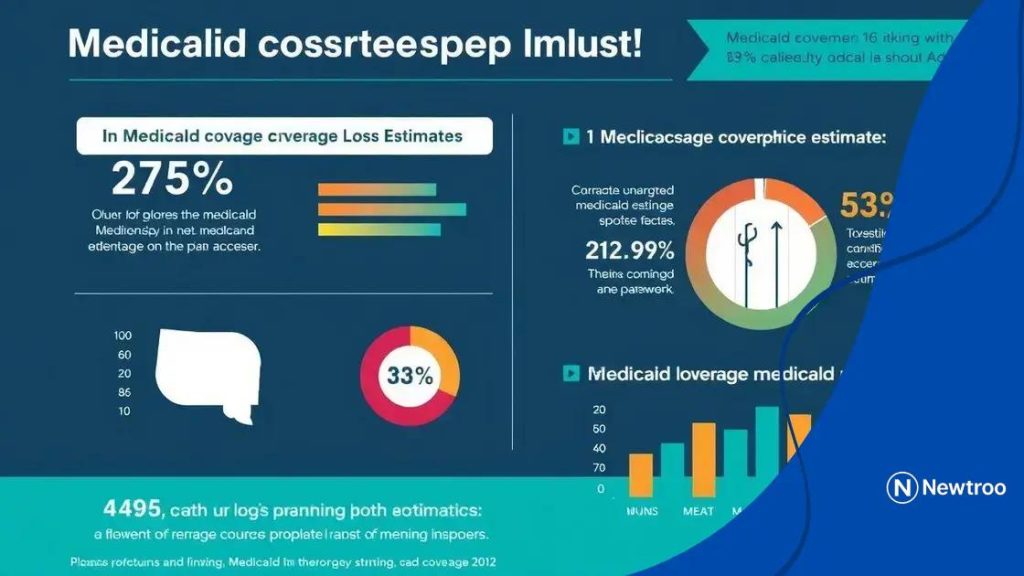Medicaid coverage loss estimates released: what you need to know

Anúncios
Medicaid coverage loss affects millions by limiting access to essential healthcare, driven by factors like policy changes, economic conditions, and eligibility criteria, highlighting the need for advocacy and support.
Medicaid coverage loss estimates released bring to light critical issues affecting access to healthcare for many Americans. As changes unfold, how will this impact you and your community? Let’s delve into the details.
Anúncios
Understanding Medicaid coverage loss
Understanding Medicaid coverage loss is essential for grasping the overall impact on healthcare access in the United States. Many individuals and families rely on Medicaid for necessary health services. As we navigate changes in policies and populations affected, it’s crucial to get a clear picture of what this coverage loss entails.
Key Reasons for Medicaid Coverage Loss
There are various factors contributing to coverage loss. The most notable include:
- Income fluctuations: Changes in employment status can push families above the Medicaid income limits.
- Eligibility changes: Policy updates may result in reevaluations of who qualifies for Medicaid.
- Administrative issues: Families might misreport information or miss deadlines, leading to unintentional losses.
Understanding these nuances sheds light on the difficulties many face when trying to maintain health insurance. Furthermore, as Medicaid programs evolve, the landscape of eligibility can shift significantly. For instance, states may alter their criteria, which can suddenly affect a large number of residents.
Anúncios
The Impact of Coverage Loss
When individuals lose Medicaid coverage, the consequences can be severe:
- Access to healthcare: Many might delay or avoid necessary medical care due to cost.
- Financial strain: Health expenses can quickly add up, leading to debt.
- Increased health risks: Without regular access to healthcare, chronic conditions can worsen.
These implications make it critical for policymakers to take notice of coverage loss trends and their effects. Community resources must also adapt to offer support for individuals facing these challenges. By focusing on prevention and education, we can help mitigate the negative impact of loss. Everyone deserves to navigate health journeys without the fear of losing their coverage.
In conclusion, recognizing and addressing Medicaid coverage loss is vital for safeguarding healthcare access for millions. By understanding the causes and consequences, we can create supportive systems for those affected.
Key factors behind the estimates
The key factors behind the estimates of Medicaid coverage loss are essential to understand. These factors help explain how conditions in different states and communities can impact the number of individuals losing their coverage. Policies, economic changes, and other dynamics play a critical role in shaping these estimates.
Economic Conditions
Economic fluctuations significantly influence Medicaid enrollment. When the economy is struggling, more people may qualify for Medicaid due to job loss or reduced income. Conversely, in a strong economy, many may find jobs with better wages, leading to a drop in Medicaid enrollment.
- Unemployment rates: High unemployment results in increased Medicaid eligibility.
- Wage growth: As wages increase, fewer individuals qualify for Medicaid.
- Inflation: Rising costs can push families into poverty, allowing access to Medicaid.
Staying informed about economic trends is vital for understanding how coverage estimates change over time. Government policies also shape Medicaid numbers by influencing eligibility rules. For instance, changes in healthcare laws or state decisions about Medicaid expansion can drastically affect coverage.
Policy Changes
Changes in government policy directly impact Medicaid enrollment. As states adjust their regulations, they can either expand or restrict access to the program. This constantly shifting landscape creates uncertainty for many families who rely on Medicaid.
- Medicaid expansion: States that have opted for expansion have seen higher enrollment numbers.
- Eligibility criteria: Adjusting income limits can either include or exclude thousands from coverage.
- Renewal processes: Stricter administrative processes may lead to unintended coverage losses.
The combination of these factors emphasizes why keeping track of such estimates is necessary. Different groups, including policymakers and health advocates, need to be aware of trends and potential changes. With the right information, they can better support individuals experiencing coverage loss. Each factor plays a role in the larger picture of health care access and security in the community.
Impact of coverage loss on families

The impact of coverage loss on families can be profoundly distressing. When families lose their Medicaid coverage, they face numerous challenges that can affect their health, finances, and overall well-being. Understanding these impacts is crucial for addressing the needs of affected families.
Health Consequences
With the loss of Medicaid, many families experience significant health consequences. Without insurance, people may delay or avoid necessary medical care, leading to worsened health conditions. Regular check-ups and preventive care become out of reach for those without coverage.
- Increased emergency visits: Families often rely on emergency rooms for healthcare.
- Worsening chronic conditions: Medical conditions can deteriorate in the absence of routine care.
- Mental health struggles: Anxiety and depression can increase due to health uncertainties and financial stress.
These health issues create a cycle that can affect not only the individual but the family as a whole. Family members may find themselves neglecting their own health to provide for others, adding more strain to their situation.
Financial Impact
The financial implications of losing Medicaid coverage are often overwhelming. Families may face significant medical bills that they cannot afford. This financial strain can lead to difficult choices about essentials like food and housing.
- Debt accumulation: Families may incur debt due to unpaid medical bills.
- Reduced quality of life: Families may cut back on basic needs out of fear of healthcare costs.
- Increased stress: Financial worries can lead to emotional and psychological stress for all family members.
This financial burden can contribute to a chaotic home environment, making it challenging for families to thrive. As these struggles escalate, families often need assistance from community resources to help bridge the gaps left by coverage loss.
Addressing the impact of coverage loss requires collective efforts from policymakers, community organizations, and health providers to ensure families receive the support they need. Awareness and education about available resources can aid those facing the challenges of coverage loss, ultimately helping families regain stability.
State-by-state analysis of losses
A state-by-state analysis of losses in Medicaid coverage provides a clearer picture of how different regions are affected by changes in health policy. Each state has its own unique dynamics that contribute to the number of people losing coverage. This understanding helps advocates and policymakers develop strategies to address specific needs.
Variation in Coverage Loss
Coverage loss varies widely from state to state based on numerous factors. Some states have expanded Medicaid under the Affordable Care Act, while others have chosen not to. This decision significantly influences the number of residents who maintain their coverage.
- Expansion states: States that expanded Medicaid often report lower rates of coverage loss.
- Non-expansion states: Many non-expansion states experience higher loss due to stricter eligibility requirements.
- Population demographics: Areas with higher poverty rates see more significant impacts.
Understanding these differences allows for targeted assistance where it is most needed. In states where coverage loss is high, families often struggle to access necessary healthcare services.
Data-driven Insights
Using available data to analyze coverage loss gives valuable insight into how policy changes affect real lives. Data such as enrollment numbers, health outcomes, and socioeconomic factors can illuminate the challenges families face in each state. For instance:
- Enrollment drops: States reporting major drops in enrollment often link this to administrative barriers.
- Health outcomes: Areas with higher coverage loss typically report worse health outcomes.
- Resource availability: States with more robust community resources often see less impact from coverage loss.
This analysis encourages states to learn from one another, adapting successful strategies used elsewhere to minimize losses and support families better. By understanding trends in coverage loss, advocates can push for reforms that ensure more families can keep their health insurance.
Future outlook for Medicaid programs
The future outlook for Medicaid programs is both promising and uncertain. As changes in health policies and economic conditions unfold, the direction of Medicaid can significantly impact millions of Americans. Understanding these potential shifts is vital for families, healthcare providers, and policymakers.
Policy Changes on the Horizon
New legislative efforts are always being proposed that could reshape Medicaid. Some states are considering expanding their programs, while others may implement stricter eligibility requirements. These actions could either improve or hinder access to healthcare services for many individuals.
- Expansion initiatives: A push for expansion could increase coverage for millions.
- Funding adjustments: Changes in federal and state funding may affect program sustainability.
- Administrative reforms: Streamlining processes could reduce bureaucracy and enhance access.
Such developments could mean better support for families who need assistance. With the right policies in place, Medicaid can continue to play a vital role in the healthcare system.
Economic Influences
Economic trends will also shape the future of Medicaid. As the employment landscape evolves, so too will the number of individuals qualifying for assistance. Economic downturns often lead to increased enrollment, while a robust economy may decrease the need for Medicaid services.
- Job market conditions: More jobs can lead to fewer people relying on Medicaid.
- Health costs: Rising healthcare costs may push more individuals back into Medicaid.
- Income levels: Changes in income can affect eligibility for many families.
Advocates argue for a more flexible system that adapts to economic changes, ensuring that Medicaid can provide support when it is needed most. The interaction between the economy and healthcare policy underlines the importance of maintaining a responsive Medicaid program.
As we look to the future, it is essential to stay informed about developments in Medicaid programs. By advocating for policies that protect and expand access to care, we can help secure healthcare for those who rely on it most. Future efforts will need to balance funding, accessibility, and quality of care to ensure that Medicaid remains a robust safety net.
FAQ – Frequently Asked Questions about Medicaid Coverage Loss
What causes Medicaid coverage loss for families?
Medicaid coverage loss can occur due to factors like income changes, policy adjustments, or administrative issues, making it important to stay informed.
How do state policies affect Medicaid coverage?
State policies significantly impact Medicaid coverage, with some states expanding eligibility while others implement stricter rules, leading to varying outcomes.
What are the health consequences of losing Medicaid coverage?
Loss of Medicaid coverage can result in delayed medical care, worsening health conditions, and increased financial strain on families.
What can be done to improve access to Medicaid?
Advocating for policy changes, expanding community resources, and raising awareness are crucial steps to ensure families retain access to Medicaid services.